Best Photo Organizing Software in 2024
Best photo organizing software includes inpixio, Canva, Visme, MAGIX PHOTO DESIGNER 7, and ACDSee. These photo organizing software helps companies with large image libraries to help their users quickly locate photos, which increases their productivity.



No Cost Personal Advisor
List of 20 Best Photo Organizing Software
High Performer | 2024
Software by InPixio
With inPixio Photo Studio, businesses can manage photo retouching processes by editing and editing digital images, correcting errors on photos, and automatically detecting colors. With this photo organizing software, photographers can easily remove backgrounds and unwanted objects from photos and enhance the colors and quality of images with automatic correction. Read InPixio Reviews
Explore various InPixio features, compare the pricing plans, and unlock the potential of seamless operations by selecting the right software for your business.
Features
View all InPixio Features- Sharing Tools
- Hardware Support
- User Interface
- Output Formats
- Remove objects
- High resolution image output
- Photo Stitching
- Layers
Pricing
InPixio Caters to
- StartUps
- SMBs
- Agencies
- Enterprises
Category Champions | 2024
Software by Canva
Canva is one of the best photo-organizing software for users to make social media graphics, posters, and other visual content. With a straightforward drag-and-drop interface and a vast selection of templates and design ingredients, such as fonts, pictures, stock photos, video and audio content, and the power to incorporate web content such as Giphy and Google Maps, anyone can create something stunning from an idea. Read Canva Reviews
Explore various Canva features, compare the pricing plans, and unlock the potential of seamless operations by selecting the right software for your business.
Features
View all Canva Features- Text Overlay
- Image Editor
- Data Import & Export
- Flowchart
- Offline Presenting
- Task Management
- Contact Management
- Speed Adjustment
Pricing
Canva Caters to
- StartUps
- SMBs
- Agencies
- Enterprises
Contenders | 2024
Software by Adobe
Adobe Lightroom is a photo editing and management software that provides a streamlined workflow for photographers. It allows users to organize, edit, and enhance their photos in a non-destructive manner. Lightroom offers powerful tools for adjusting exposure, color balance, and other aspects of an image. Read Adobe Lightroom Reviews
Explore various Adobe Lightroom features, compare the pricing plans, and unlock the potential of seamless operations by selecting the right software for your business.
Features
View all Adobe Lightroom Features- Output Formats
- Remove objects
- Layers
- Scripting/Batch Processing
- Image search and filtering
- Photo Enhancement
- Import/ Export Functions
- Filtering
Pricing
Starter
$ 10
Per Month
Adobe Lightroom Caters to
- StartUps
- SMBs
- Agencies
- Enterprises
Emergents | 2024
Convey the most powerful visual stories & content
Visme is an all-in-one image-sorting software that empowers non-design professionals at leading companies to develop and share compelling presentations, documents, visual reports, and other visual formats in less duration. Users can organize project data into folders, collaborate, and team members or individuals can obtain role-based permissions. Learn more about Visme
Explore various Visme features, compare the pricing plans, and unlock the potential of seamless operations by selecting the right software for your business.
Features
View all Visme Features- Filtering
- Templates
- Image Editor
- Contact Management
- Training Management
- Image Database
- Presentation Management
- Performance Management
Visme Caters to
- StartUps
- SMBs
- Agencies
- Enterprises
Emergents | 2024
Software by Xequte , Inc
You can manage and view all standard images, documents, sounds, and video files with Smart Pix Manager, an easy-to-use photo cataloging software. Browse your computer folders quickly, or search your files with keywords, descriptions, and content. With its powerful editing tools, you can remove red eyes, rotate, crop, etc., without losing details. Automatically generate keywords from sound and digital photo fields and file and folder names. Learn more about Smart Pix Manager
Explore various Smart Pix Manager features, compare the pricing plans, and unlock the potential of seamless operations by selecting the right software for your business.
Smart Pix Manager Caters to
- StartUps
- SMBs
- Agencies
- Enterprises
Emergents | 2024
Software by ZONER, Inc
Among the most popular picture organizer software, Zoner Photo Studio combines fast RAW photo handling with good organizational tools and layer-based editing to produce a powerful editor that can take on both Lightroom and Photoshop well. You can even use your edited images in photo books and calendars and even create a basic video with the help of some extras such as cloud storage and creative uses. Learn more about Zoner Photo Studio
Explore various Zoner Photo Studio features, compare the pricing plans, and unlock the potential of seamless operations by selecting the right software for your business.
Zoner Photo Studio Caters to
- StartUps
- SMBs
- Agencies
- Enterprises
Contenders | 2024
Software by Google Inc.
Google Photos is the best photo sorting software that allows you to store and share photos across your devices for free, with unlimited storage and photo sharing. In addition to its built-in security infrastructure, it protects data from online threats using encryption technology behind five layers of protection. Read Google Photos Reviews
Explore various Google Photos features, compare the pricing plans, and unlock the potential of seamless operations by selecting the right software for your business.
Google Photos Caters to
- StartUps
- SMBs
- Agencies
- Enterprises
Emergents | 2024
Software by ACD Systems International
ACDSee Pro is an amazing picture-sorting software offering comprehensive photo editing, video editing, and digital asset management (DAM) products. In addition to managing, enhancing, and sharing media files and projects, the platform is designed for professional photographers, video editors, and graphic designers. The application allows professionals to create image stories, organize assets, sort and search files, and edit images, videos, and music. Learn more about ACDSee
Explore various ACDSee features, compare the pricing plans, and unlock the potential of seamless operations by selecting the right software for your business.
Features
View all ACDSee Features- Search/Filter
- Asset Library
- Metadata Management
- Asset Sharing
- Asset Categorization
ACDSee Caters to
- StartUps
- SMBs
- Agencies
- Enterprises
Emergents | 2024
Software by MAGIX Software GmbH
MAGIX PHOTO DESIGNER 7 is an all-in-one image editing, illustration, and desktop publishing solution with an intuitive user interface and innovative real-time tools. With just one program, you can edit multiple projects and export them for various purposes: such as images, PDF files, documents, etc. Highlight the object you want to be removed and click 'magic erase.' The unwanted object is then automatically replaced with pixels sampled from the photo. Read MAGIX PHOTO DESIGNER 7 Reviews
Explore various MAGIX PHOTO DESIGNER 7 features, compare the pricing plans, and unlock the potential of seamless operations by selecting the right software for your business.
- Scripting/Batch Processing
- Remove objects
- Trim & Slice
- Audio Waveform
- Import/ Export Functions
- Animations
- Fit Images Perfectly
- Photo Stitching
MAGIX PHOTO DESIGNER 7 Caters to
- StartUps
- SMBs
- Agencies
- Enterprises
Contenders | 2024
Software by Purch Marketplace
With Coral PaintShop Pro X8, you can work with various new tools, enhanced features, and essential tools that all photo editors need. You can buy PaintShop Pro X8 as a standard or top edition, depending on what you want and how much budget you have. Designed for the photo enthusiast who wants to manage, edit, and adjust photos in one package at a price that is easy to use. Read Corel PaintShop Pro X8 Reviews
Explore various Corel PaintShop Pro X8 features, compare the pricing plans, and unlock the potential of seamless operations by selecting the right software for your business.
- Output Formats
- Adjusting Image' Colors
- Fit Images Perfectly
- Transparent Backgrounds
- Import/ Export Functions
- Alignment and Straightening
- Photo Stitching
- Project Management
Pricing
Starter
$ 55
Onetime
Corel PaintShop Pro X8 Caters to
- StartUps
- SMBs
- Agencies
- Enterprises
Emergents | 2024
Software by Adobe
Adobe Bridge, a cloud-based image organization software, offers real-time editing and other features. The creative asset workflows in Adobe Bridge let users visualize all their creative assets, organize them with metadata and labels, and find assets by searching, filtering, and collecting. In addition to importing images, editing them, and importing/exporting in batches, Adobe Bridge has photo editing capabilities that businesses can use. Learn more about Adobe Bridge
Explore various Adobe Bridge features, compare the pricing plans, and unlock the potential of seamless operations by selecting the right software for your business.
Adobe Bridge Caters to
- StartUps
- SMBs
- Agencies
- Enterprises
Contenders | 2024
Software by CyberLink Corp
Cyberlink PhotoDirector 365 is a great photo organizer software with many easy-to-use features. The latest updates provide AI-based algorithms that enrich grainy images, remove unwanted objects from photos, or make cartoon effects from photos. The interface is extremely clean and sparse, and PhotoDirector's interface is incredibly simple. Read PhotoDirector Reviews
Explore various PhotoDirector features, compare the pricing plans, and unlock the potential of seamless operations by selecting the right software for your business.
Features
View all PhotoDirector Features- Image Editing
- Fit Images Perfectly
- Digital Retouching
- Color Correction
- Alignment and Straightening
Pricing
PowerDirector 365
$ 55
Per Month
PhotoDirector Caters to
- StartUps
- SMBs
- Agencies
- Enterprises
Emergents | 2024
In-built library of 100,000 images
Digikam is the best photo catalog software for organizing and managing edited photos. If you like detailed settings, this editor is the best choice since it offers many tools. Due to the extensive image editing options of meta and geo-data and the support of numerous social networks, DigiKam is an easy and fast way to publish photos. It is a combination of an organizer and an image-retouching program. Read Digikam Reviews
Explore various Digikam features, compare the pricing plans, and unlock the potential of seamless operations by selecting the right software for your business.
Features
View all Digikam Features- Photo Enhancement
- Import/ Export Functions
- Publish photo templates
- Remove objects
- Photo Stitching
- Bitmap To Vector Conversion
- Output Formats
- Alignment and Straightening
Digikam Caters to
- StartUps
- SMBs
- Agencies
- Enterprises
Emergents | 2024
Software by Canto, Inc
The best photo-organizing software, Canto enables brands in all industries to manage their digital assets and get the most out of them by facilitating the digital content collection, management, and sharing. Digging through folders and hunting down files is no longer necessary, as Canto is a centralized hub for digital content – including images, videos, collateral, and additional digital assets. Learn more about Canto
Explore various Canto features, compare the pricing plans, and unlock the potential of seamless operations by selecting the right software for your business.
Features
View all Canto Features- Asset Categorization
- Asset Library
- Customizable Branding
- Metadata Management
- Version Control
- Approval Workflow
- Watermarking
- Project Management
Canto Caters to
- StartUps
- SMBs
- Agencies
- Enterprises
Contenders | 2024
Software by CyberLink Corp
A photo organizing software from Cyberlink, PhotoDirector 8 Ultra offers layers, filters, effects, etc. It can handle various proprietary raw formats, including Windows and Mac, and is compatible with both. It also offers over 100 lens profiles for correction options. If you want to purchase the software, you can download it for £79.99, with a 30-day free trial. Read PhotoDirector8 Reviews
Explore various PhotoDirector8 features, compare the pricing plans, and unlock the potential of seamless operations by selecting the right software for your business.
Features
View all PhotoDirector8 Features- Transparent Backgrounds
- Red Eye Correction
- Adjusting Image' Colors
- Remove objects
- Output Formats
- Lasso Tools
- Layers
- Automatic photo template rendering
Pricing
Deluxe
$ 60
One time
Ultra
$ 100
One time
Suite
$ 150
One time
PhotoDirector8 Caters to
- StartUps
- SMBs
- Agencies
- Enterprises
Emergents | 2024
Pro editing at cost-effective pricing
A powerful, smooth, and best photo organizing software, Picktorial allows you to enhance and retouch photos. You can adjust RAW photos locally, retouch portraits, add filters, watermarks, and more. Or, you can continue to use Picktorial for individual photos or folders, bypassing the time-consuming import process of other apps to enjoy the power of Picktorial right from Photos. Learn more about Picktorial
Explore various Picktorial features, compare the pricing plans, and unlock the potential of seamless operations by selecting the right software for your business.
Features
View all Picktorial Features- Import/ Export Functions
- Color Correction
- Image Editing
- Adjusting Image' Colors
- Layers
- Project Management
- Panorama montage
- User Interface
Picktorial Caters to
- StartUps
- SMBs
- Agencies
- Enterprises
Emergents | 2024
Software by PhotoWorkflo
PhotoWorkflo is a leading photo archiving software and the only fine art photography management tool developed by photographers for photographers. By uploading your most important images to your PhotoWorkflo catalog with titles, keywords, and copyright information, you can organize your master images into collections, making it easy to find what you are looking for or put together an exhibition. Learn more about PhotoWorkflo
Explore various PhotoWorkflo features, compare the pricing plans, and unlock the potential of seamless operations by selecting the right software for your business.
Features
View all PhotoWorkflo Features- Marketing Management
- Proposal Management
PhotoWorkflo Caters to
- StartUps
- SMBs
- Agencies
- Enterprises
Contenders | 2024
Software by Corel Corporation
With each iteration, picture organizer software Pinnacle Studio Ultimate has steadily become faster and more powerful. Pinnacle offers excellent editing options and effects like stop-motion video, multi-cam editing, and motion tracking. It offers professional post-production polish without requiring subscriptions, so check out Pinnacle Studio 25 Ultimate if you're looking for high-end video editing. Read Pinnacle Studio Reviews
Explore various Pinnacle Studio features, compare the pricing plans, and unlock the potential of seamless operations by selecting the right software for your business.
Features
View all Pinnacle Studio Features- Trim & Slice
- Animations
- User Interface
- Cross Platform
- Video Effect
- Title Editor
- 3D Animation
- 3D Modeling
Pinnacle Studio Caters to
- StartUps
- SMBs
- Agencies
- Enterprises
Contenders | 2024
Software by Photolemur
Image organization software like Photolemur uses Artificial Intelligence (AI) technology to transform your photos automatically. This software produces high-quality images without the hassle of manual editing. In addition to the advanced artificial intelligence, the program creates professional-looking images from amateur endeavors by automatically adjusting the settings to the best ones. Read Photolemur Reviews
Explore various Photolemur features, compare the pricing plans, and unlock the potential of seamless operations by selecting the right software for your business.
Photolemur Caters to
- StartUps
- SMBs
- Agencies
- Enterprises
Contenders | 2024
Software by Everimaging Limited
Using Fotor, anyone can edit photos and create invitations, fliers, and cards. Fotor, one of the best photo sorting software, has various design templates that can be customized to suit a project's needs. Users can use Fotor to blur backgrounds, smooth skin, etc., to specific picture parts. A range of full and partial filters are available as well. Read Fotor Reviews
Explore various Fotor features, compare the pricing plans, and unlock the potential of seamless operations by selecting the right software for your business.
Features
View all Fotor Features- Remove objects
- Restore photos
- Color Correction
- Organizing Capabilities
- Alignment and Straightening
- Photo Stitching
- Sharing Tools
- User Interface
Pricing
Fotor Pro
$ 9
Per Month
Fotor Caters to
- StartUps
- SMBs
- Agencies
- Enterprises
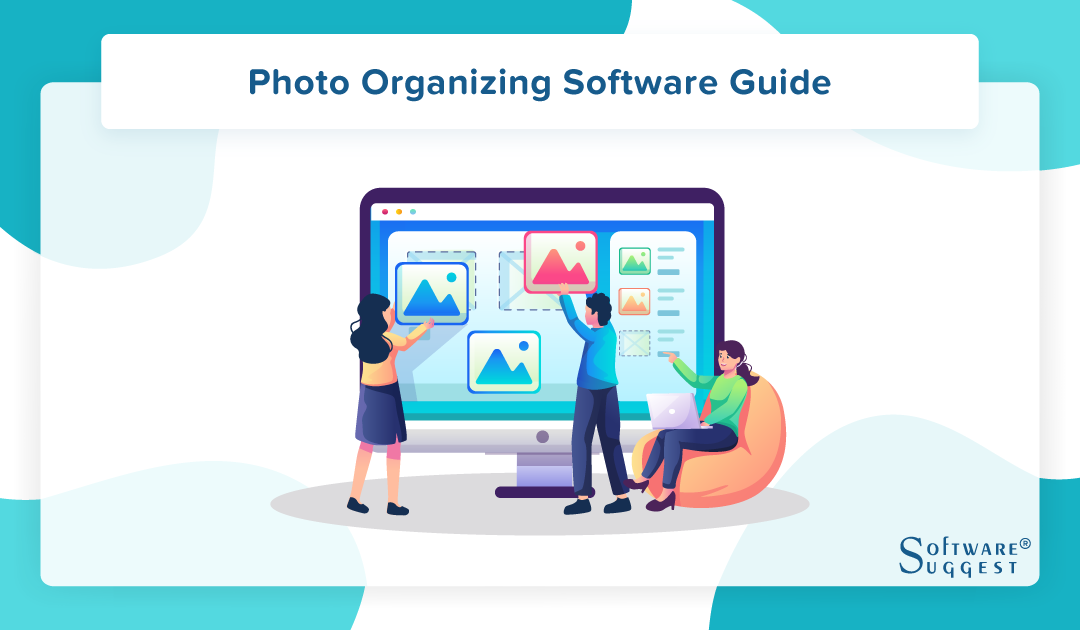
Professional photographers frequently wind up with overwhelming images, making organization difficult. You must maintain a productive workflow and streamline the photo process. Organizing your images is a crucial step in this process.
A skilled photographer might take more than one hundred pictures in one session. Consider doing this for a month; you will have thousands of photographs. So, selecting the top few pictures from that list of 1,000 images can be complex.
So, for creative professionals and enterprises, maintaining these endless folders of photographs and organizing and storing digital images has become a priority.
Some of the software mentioned in this blog enables you to tag, keyword, and filter your images. Also, it permits you to publish photos straight on social network.
What Is Photo Organizing Software?
Using photo organizing software, companies and individual users may rapidly and securely save, retrieve, and arrange vast quantities of digital photographs. It is frequently utilized by marketers, designers, media departments, and photographers and is also known as picture-organizing software.
Although sometimes referred to as "digital asset management," or DAM, digital asset management software provides far more than merely assisting in organizing your library of photographs. DAM is a type of photo organization software.
It offers a central location for collecting and sharing photographs while streamlining operations. Software for managing photos also lessens the possibility of using duplicate files or erroneous images. With only a few clicks, users of the top picture organization software can import or export images in several formats.
It facilitates easy collaboration with many parties, including agencies, independent contractors, and corporate workers. It establishes privacy and usage restrictions. Thus, enabling brands and content producers to safeguard copyright and regulate access.
Set expiration dates to track usage with the least effort. Brands that optimize processes, save time, foster creativity, improve security, and lower errors should use photo-organizing software.
Why Do You Need Photo Organizing Software?
Picture organizer software is essential for any professional who wants to focus only on creativity and skills. A lot of time gets taken away in organizing and tracking the pictures. Thus, there are 4 proper reasons to justify why you need image organization software.
-
Easy to find photos
Think about how you will locate the pictures from previous years. For example, if a year after the photo shoot, a client wishes to buy a specific one? You should have a proper system on the computer to find them. If you need to submit a few nature images for a competition, you can keep searching for days for one perfect photo.
You need to know what works best for you when you organize the images. It might involve adding keywords, stars, tags, or color codes. Also, you should be acquainted with the system. This way, you can use it effectively when an excellent opportunity presents itself.
-
Check your progress
Checking progress is very important, especially if someone is in the creative sector. Here, photography is both a creative and skill-oriented profession. By using photo organizing software, you can track your progress. You can analyze the skills you've acquired and the flaws you made earlier.
The feature of tracking past images adds to your skills, as if pointed out, you can easily rectify it. You can only improve if the anomalies are tracked, and you focus on enhancing them. Thus, such software is essential when it comes to tracking your progress.
-
Deep analysis
You can easily analyze your photographs by choosing your best work. Investigate the reasons behind your preferences for various photographs. Consider what inspired you in the first place to take positive pictures. Also, what went wrong with the negative ones?
It also offers many ads on features, which will justify why you should use it at once. By doing this, you'll look better and be able to produce better photographs. Data analysis in any field is very important. But when it comes to a creative sector like photography, without software, it becomes difficult to analyze.
-
Revisit ideas
Concepts can change quickly. Yet it's incredibly hard to pinpoint the idea that inspired you to produce your best work. Searching for the image you believe best captures your concept is, therefore, crucial in this situation.
There may be instances where a client requests a specific image that you captured several years ago. In this situation, obtaining the image is as simple as clicking if you have photo organizing software. To recall things, you must have a unique system for tagging them. You can easily add keywords, color codes, and other marking options here to make your search quicker and more precise.
How Does Photo Organizing Software Work?
Locating specific images can be made simpler with photo organizer software. Firstly, organizing photos may feel like a huge task, but it can be broken down into a few straightforward steps.
The ideal method to arrange images depends on the user, the situation, and the available digital asset management tools. There are, however, various techniques that will ensure to make a photo collection both accessible and organized.
Gathering all of the photos in one location is the first step in arranging photos. The photographs may then be uploaded to a single hard drive as the next step. The photographs must first be sorted after being gathered in one place.
An organizational structure is useful in this situation. Themes or dates can be used to sort photos. As a photo is inherently a snapshot of a particular moment, most people like to organize their photos by date. Many software tools may automate this process.
You can assign keywords to each image using photo-organizing software like Adobe Photoshop Elements. Future family members will be able to recognize the people in a photo thanks to the information stored in it, regardless of whether a database is lost or destroyed.
Your camera also includes the date and time the photo was shot. When you view an image, photo-organizing software "reads" this data and displays it to you.
Benefits of Photo Sorting Software
If you take a lot of images, you are probably aware of how difficult it is to get them organized. Image sorting software photos can help with that.
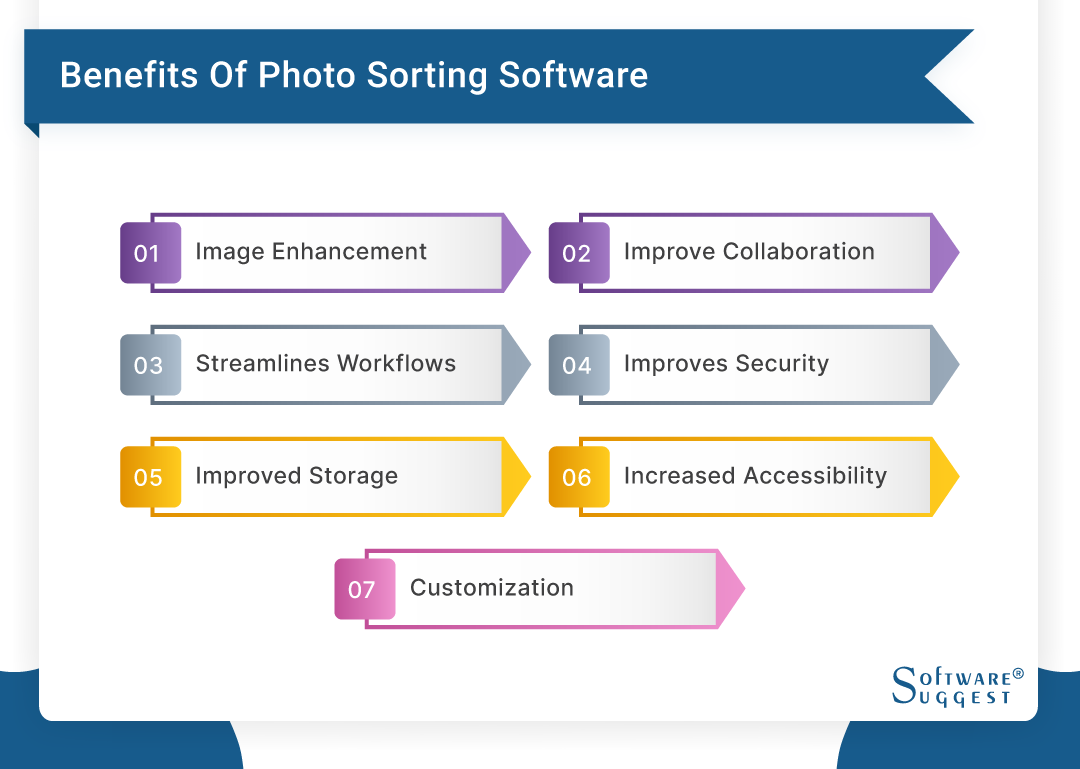
-
Image enhancement
Photo organization software with image-enhancing features can be exactly what you need if you're sick of pictures that look flat or uninteresting. Enhancing your photographs is one of the main advantages of photo organization software.
With the help of these tools, you may alter the brightness, contrast, sharpness, color balance, and more to transform ordinary images into magnificent works of art. You may change your entire photo library and give your pictures new life with only a few clicks.
Photo organizing software with picture enhancement is a crucial tool if you want to make the best use of your photos and produce amazing visual material.
-
Improve collaboration
Digital picture sourcing, sharing, and management take time away from the creative process. To give brands more time to focus on creating excellent work, picture organizing software, also known as photo tagging software, offers a central platform. Here stakeholders, such as outside agencies and freelancers, can access and interact with digital photographs quickly and efficiently.
-
Streamlines workflows
With picture organizer software, brands can quickly find, edit, and distribute images. They also customize the platform to meet their specific business requirements. Every user can be sure they are utilizing the appropriate file, reducing bottlenecks and errors. This ultimately streamlines the workflow resulting in better productivity in the firm.
-
Improves security
With such software, security is enhanced with the centralized picture repository. It lets you have full control over your photographs, boosting security and guaranteeing that everyone is adhering to brand requirements.
Again, you have total control over access and copyright. It means you can stop depending on email servers or external hard drives. Now you can always know how and where your photographs are being used.
-
Improved storage
It is one of the main perks of image editing software. You can keep your images and photos using this type of software in a logical and convenient manner. Searching for the photographs you're looking for is simple due to its ability to sort your photos by date, event, location, and more.
-
Increased accessibility
It is provided by image editing software is another advantage that can be counted. You only need an internet connection, and you may access your images from any location. If you want to share your images with friends and family, it is extremely smooth and helpful.
-
Customization
And lastly, customization is possible with image editing software. It is simple to find the photographs you're looking for since you can personalize how your photos are categorized and displayed. Also, a lot of apps provide functions like automatic tagging that help you save time and effort.
Features of Photo Organizing Software
If you enjoy shooting photos, then you know how vital it is to keep them organized. Digital photo organizer software may help with this. There are various options for photo organization software on the market right now.
They all provide various features and tools. Let’s look at 9 main elements that you need to look for in photo organizing software.
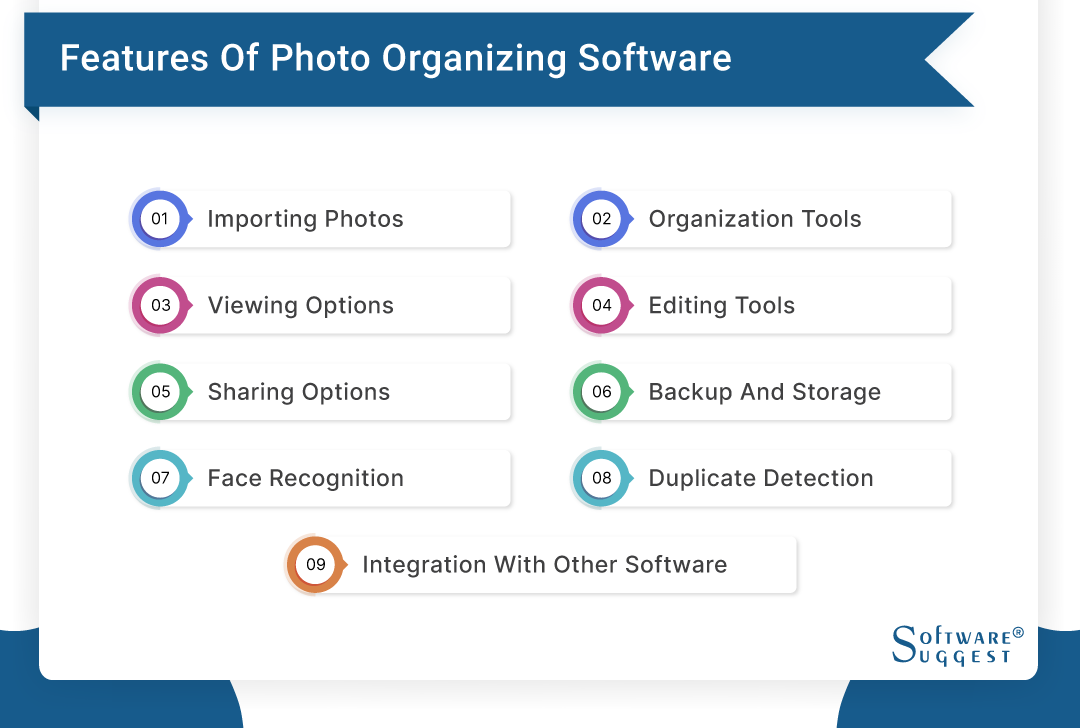
-
Importing photos
In this digital world, importing photos should be very streamlined. Smart photo-importing features increase the productivity and speed of work. Let it be social media, camera, or mobile, image-organizing software brings everything to a single location and helps you organize accordingly.
Thus, to organize them into albums or folders based on your preferences, such free photo organizing software is a must-buy.
-
Organization tools
It is another vital feature of photo organizing software. It will allow you to sort your photos into folders, albums, and tags. Once you use this software, it is easy to find the photos you're looking for.
For example, you can organize your photos by date, location, or subject matter. Many photo organizing software options also come with auto-tagging features, which can automatically tag your photos based on specific criteria, such as people, places, and objects.
-
Viewing options
You may view your images in a plethora of different ways with photo organizing software. Did you know that? You can use a variety of options to organize your photos by date, location, and even color! This makes searching through your collection for particular photos really simple.
Yet, there's still more! Even more, viewing options, such as slideshow mode, are available with some software alternatives. When you want to relax and watch a slideshow of all your favorite photos, this is ideal. It's a wonderful way to display your images and relive your most treasured moments.
-
Editing tools
Many photo organization software choices include editing tools in addition to organizing your photos. You can use these tools to perform simple photo editing tasks like altering brightness, contrast, and saturation.
Some software choices also offer more sophisticated editing tools, like those for erasing red-eye or imperfections from photographs. It can still be utilized to perform simple photo modifications even though they might not be as powerful as those in specialized photo editing software.
-
Sharing options
This feature is very important today. People click images to share them with their friends and family. Social media has made it a trend where sharing pictures and getting likes is a way of life. Here, image organizing software helps you to streamline the process of sharing your photographs via various mediums like emails, social media, links, etc.
-
Backup and storage
Two more essential components for photo organizing software are backup and storage. Several software substitutes include built-in backup and storage features that help to ensure the protection and security of your images.
With certain software alternatives—some of which even offer cloud storage options—you can simply access your photographs from anywhere. All that is required is an internet connection.
-
Face recognition
Image archiving software is very smart. One of the smart features is the face-recognition. It can easily identify the faces. The tagging feature acts as a subsidiary function. When the software recognizes any face, it automatically tags that particular person. Such smart functions can be very useful to keep track of photographs having important persons to be tagged on.
-
Duplicate detection
The photo album organizer software must also include duplicate detection. The software can identify duplicate photographs thanks to this capability. It instantly removes them or combines them into a single image. By doing this, you may prevent having duplicate images that eat up important storage space.
-
Integration with other software
Last but not least, several alternatives for photo organization software provide connectivity with other programs. As an illustration, certain choices might be compatible with picture editing software, enabling you to quickly modify your photos inside the organizing program. You might be able to simply share your images on social media sites using other tools that link with those websites.
How To Choose The Best Photo Organizing Software?
Choosing the best photo organizing software is a daunting task. But we've compiled 5 considerations that will help you select the best one. Here are the metrics to be followed:-
-
Search for a fast and responsive app
The pace of your app is crucial in the quick-paced world of today. Make sure the program you choose can download, upload, and process photographs quickly. Otherwise, your patience will run out.
The application should sync all updates instantly so that you and your team may work with your photographs in real time. Think about uploading all the negatives but not letting your colleague see them for additional editing.
Make absolutely sure the software is responsive across all platforms and devices as well. The best option is to select online photo organization tools. After that, you won't need to worry about downloading or implementing anything.
Don't forget to test the free photo organizing software with some photographs before making any decisions. It will help you determine the software's responsiveness and quickness. Also, it will depict whether it lives up to your expectations or not.
-
Check the storage capacity
Another important consideration while selecting photo organizing software is storage space. Images don't appear to take up much room at first sight. Yet you must be aware, as a photographer, that this couldn't be further from the reality.
You maintain all of your recent pictures, raw files, prior projects, backup materials, etc. And in this situation, you require a really huge storage capacity.
You may, of course, make use of some conventional storage choices. These are safe, affordable, and expandable, like Faststone image viewer. Most significantly, they give you infinite storage space, which is the goal of every photographer.
But keep in mind that cloud storage won't assist you in accessing or organizing your photographs. You will be left alone to battle the chaos in your media library. Consider solutions that may be added on top of your preferred storage as an alternative. For instance, certain DAM applications assist you in organizing your images without pressuring you to switch storage.
-
Care about security and privacy
As a pro, you need to take the security level of your preferred photo-organizing program into account. Keep all of your creations secure and secret, and don't worry that they'll end up somewhere inappropriate someday.
If you don't adequately protect your content, several risks are waiting for you, including file loss, data leakage, and hacking threats. Check the security features of any photo organization software you use, such as two-factor authentication, encryption, etc. Also, keep in mind your backup strategy in case you still overlook something.
-
Consider the ease of use
This photo organization tool will be used frequently by you and your teammates. Thus ensure that your program is simple to use and intuitive. Even if it's your first time using it, you should have no trouble using any of the capabilities.
Moreover, check to see if your app interfaces with other apps you frequently use for business. The majority of photographers, for instance, will like the integration with Adobe CC products. Integrations with Google Workspace, Slack, and social media may also be handy.
Having a built-in photo editor will be quite helpful. It doesn't need to be extremely formal. But, there are instances when you need to make quick adjustments like boosting the brightness, resizing, or cropping the picture.
-
Look for the sharing options
When you do photography, sharing is an essential function in your daily task. It is 10x easier when you do it from a single software to various platforms at once. You should look for software that has an album creation feature and lets you customize it as per your requirements.
This feature is often seen in image software which offers sharing options via a single link making it much easier to send one by one to each potential client. Also, social media sharing is a must in such software. So look into that too.
-
Mind collaboration potential
You'll eventually require a photo management program designed for collaborative work. There will come a point when you consider partnering, even if you prefer to operate alone as a lone wolf. You won't have to go through the hassle of switching apps and beginning over, of course.
Finding the best free photo organization software that organizes photos and promotes collaboration early on is preferable.
Your solution should enable you to post comments, tag your coworkers, and perhaps include some visual cues to help them understand the topic you want to talk about. Also, sharing your photos with teammates should be simple.
Top 5 Photo Organizing Software with Pricing, Pros & Cons
After discussing the common features, how you should choose, and its works, it's high time to reveal the top 5 Photo Organizing Software.
|
Name
|
Free Trial
|
Demo
|
Pricing
|
|---|---|---|---|
|
Adobe Lightroom Classic |
7 Days |
Yes |
Starts at $54.99 |
|
Google Photos |
No |
No | Starts at $0.18 |
|
Adobe Bridge |
7 Days |
Yes |
Free |
|
Apple Photos |
No |
No |
Starts at $0.99 |
|
Magix Photo Manager |
30 Days |
Yes |
Starts at $36.33 |
1. Adobe Lightroom Classic
The first excellent photo cataloging software is Adobe Lightroom. which is also known as Adobe Photoshop Lightroom. It is compatible with Windows, iOS, macOS, Android, and tvOS (Apple TV). Large amounts of Adobe photoshop elements like digital photographs can be imported, viewed, saved, organized, edited, tagged, and shared with this software.

Key Features
- Combine several HDR images into a single image
- Enter names and use keywords to find people
- Include images in fresh or current collections
Pros
- Great organizing and management of the photos
- For local modifications, use auto masking
- Facial recognition and a map with geotags
- Plug-in assistance
- Free version available
- Mobile application with connectivity
Cons
- Needs subscription
- Initial raw conversion could have been much better
Pricing
- It starts at $54.99 per month
2. Google Photos
Google photos is a photo organizing software that allows users to share and store photos. Individuals may organize, store, edit, and share their digital photographs with this partially free photo organizing software, which was published in May 2015. Google photos automatically back up your photographs and organize them in a searchable style. Also, you can edit or annotate your photographs using Google Lens.

Key Features
- Google photos automatically arranges by people, places, and objects
- AI-powered search by entering keywords or describing what's google photos
- Simple sharing and teamwork are offered by google photos
Pros
- Quick photo uploading
- Options for simple cooperation
- Device-to-device sync
- Advanced sorting and search
Cons
- Storage is limited
- No option for meta-data
Pricing
- You can check the prices here
3. Adobe Bridge
For managing all of your digital data, including images, Adobe has a free tool. This photo organizer software can be used separately from Adobe's Creative Cloud program. Tags, ratings, and other metadata can be added to your photographs using Adobe Bridge, one of the best photo organizing programs. You can simultaneously sort several photographs with the application.
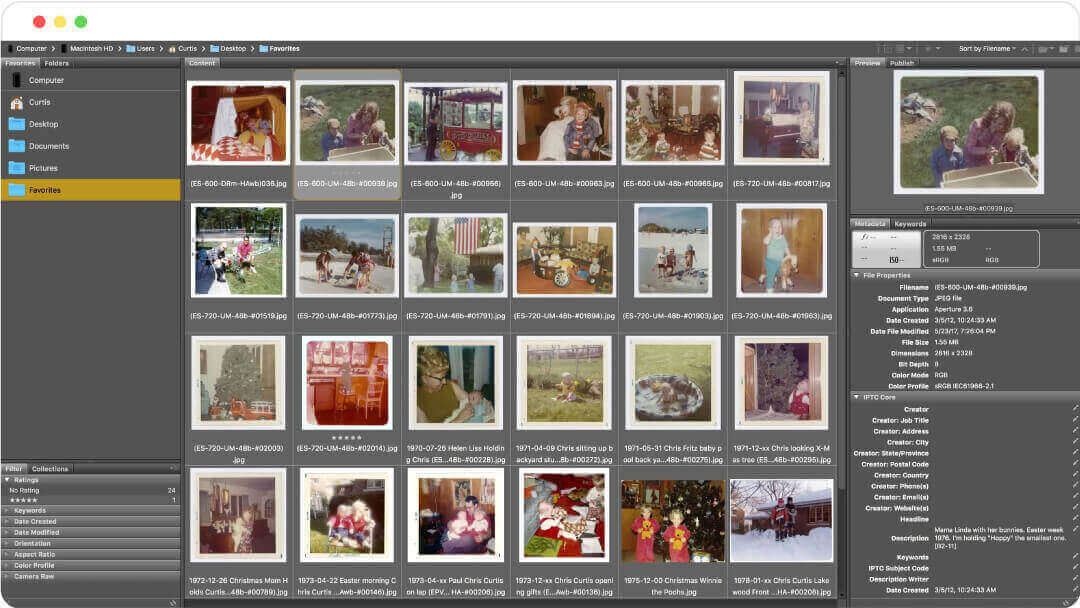
Key Features
- Folder structure arrangement
- Groupings of related assets or galleries
- Search functionality based on metadata
Pros
- Sorting and ranking images
- Robust support for metadata
- Adaptation to Adobe applications
Cons
- UI can be improved
- Needs high memory for optimal performance
Pricing
- Free
4. Apple Photos
Apple Photos is among the top photo organizer programs. It is a rather straightforward piece of free photo management software. The software enables the creation of slide displays depending on a time or date. Images can be arranged using Apple Photos' object and scene detection.

Key Features
- Identify the objects and scenes
- Best-quality processing of raw images and videos
- Loop video and long exposure output are excellent
Pros
- Cloud syncing and backup
- Cool tips for the iOS Live Pictures
- Excellent UI experience
Cons
- The web interface might require improvement.
- Only available within the Apple ecosystem
Pricing
- Custom Pricing
5. Magix Photo Manager
You can add the same photograph to several collections using the Magix photo manager virtual album feature without taking up additional hard drive space. Its facial recognition feature is unquestionably intriguing.
To discover duplication, the application use AI technology. This photo organizer software offers some fundamental editing features, like cropping, light correction, and other image enhancement tools.
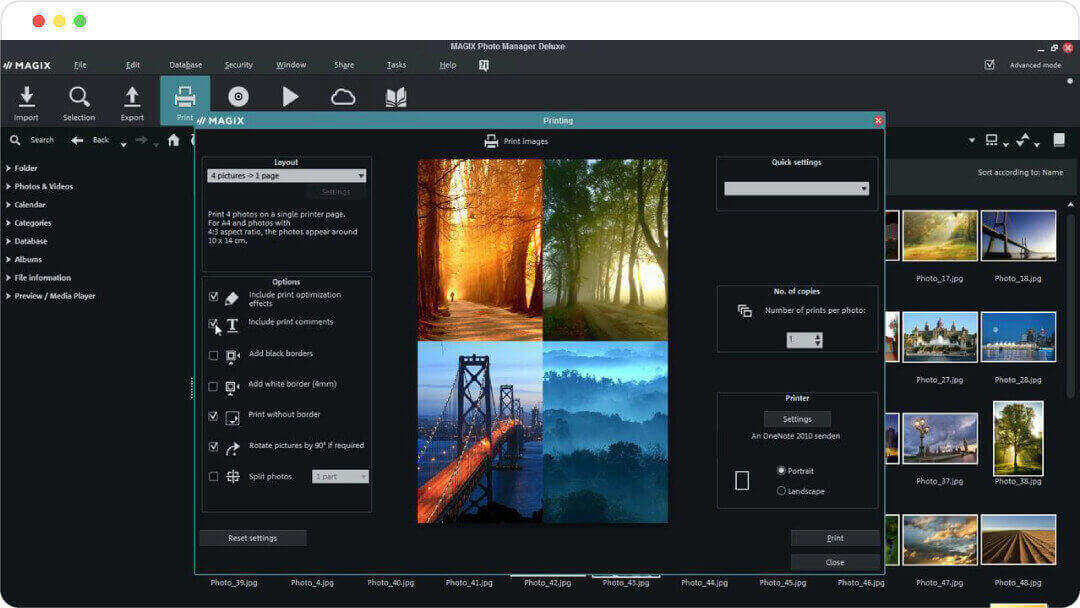
Key Features
- Facial recognition
- Suggests similar content
- Rate and categorize a photo
Pros
- Supports most of the formats
- Data-based search
- Provides basic editing tools
- Can use for free
Cons
-
It comes with Adware
Pricing
- The price is $36.33
Challenges In Photo Organizing Software
Photo organizer software has become very trendy with the rise of digital photography, but it still faces a number of challenges.
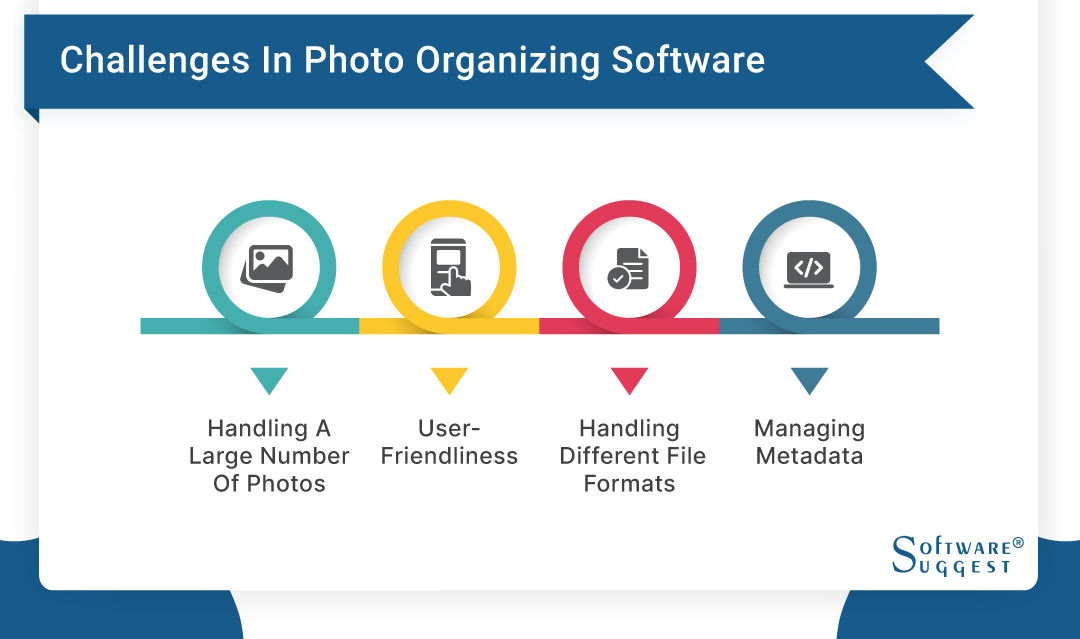
-
Handling a large number of photos
Dealing with many images is one of the biggest problems with photo organization software. It can be challenging to organize the thousands of digital photographs that various users have.
-
User-friendliness
Another challenge is ensuring that the photo organizer is user-friendly. Some users may find photo organizing software to be too complicated. They may not understand how to use certain features.
-
Handling different file formats
Another challenge is ensuring that the photo organizer is user-friendly. Some users may find photo organizing software to be too complicated. They may not be comfortable using certain features.
-
Managing metadata
Additionally, it must be capable of managing metadata effectively. This contains details like the time and place the photo was taken as well as any tags or keywords the user may have added.
Current Trends in Photo Sorting Software
With the increasing number of photos being taken every day, it has become essential to have reliable photo organizer software. Here are some current trends in photo sorting software:
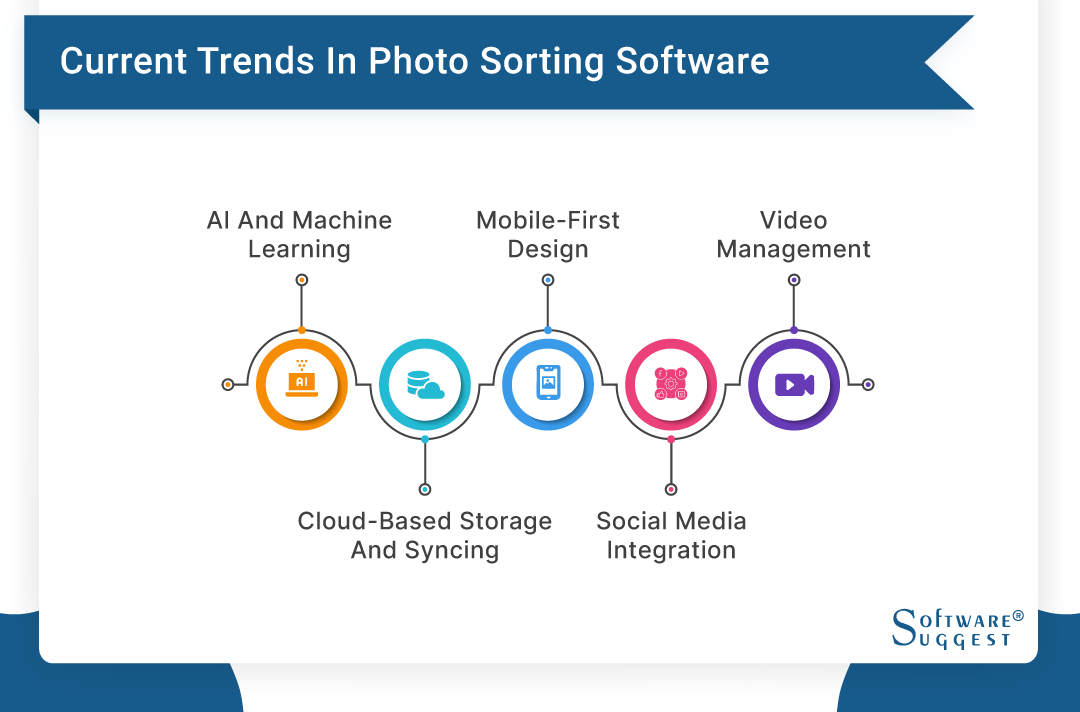
-
AI and Machine Learning
The way we organize and manage our photos is changing. It is because of artificial intelligence (AI) and machine learning (ML). Your photos can be automatically categorized based on their content using AI-powered photo sorting software makes it simpler to locate particular images. For e.g., the AI-based photo editing program Skylum AI provides fantastic and quick editing choices. It is the first image editor that is entirely controlled by artificial intelligence.
-
Cloud-based storage and syncing
For organizing images, cloud-based storage and synchronization have grown in popularity. You can keep your images online using cloud-based storage, making them reachable from any location with an internet connection. Popular cloud-based photo storage options include Google Drive and Dropbox. Excire would be an excellent alternative, though, if you're not happy with having your images stored on the cloud.
-
Mobile-first design
Another trend in photo sorting software is a mobile-first design. Developers are creating apps with mobile users in mind as more people than ever before are using their smartphones to capture images. Because of the app's mobile-first design, it is simple to organize and manage your images while you're on the go.
-
Social media integration
The importance of social network integration for photo sorting software is rising. On social networking sites like Instagram and Facebook, many people post images. It is simple to share your images right from the app due to photo sorting software that interfaces with various platforms.
-
Video management
The administration of videos is an additional advancement in photo organizer software. Programmers are developing apps that can manage both photos and videos as more people use their phones to shoot videos. You can add both pictures and movies to Adobe Lightroom's library, for instance.
Conclusion
We have discussed all the best photo organizer software. It is clear that people who are into photography or have a passion for it should be acquainted with the above-mentioned photo organizer software.
Even though we have listed all the criteria for your ease, practically you should buy as per your own choice. The photo organizer applications are essential for streamlining your professional career and increasing your productivity. Thus, you should definitely utilize such photo organizing software for more productivity in a better-organized manner.








.png)


.png)




.png)




.jpg)

